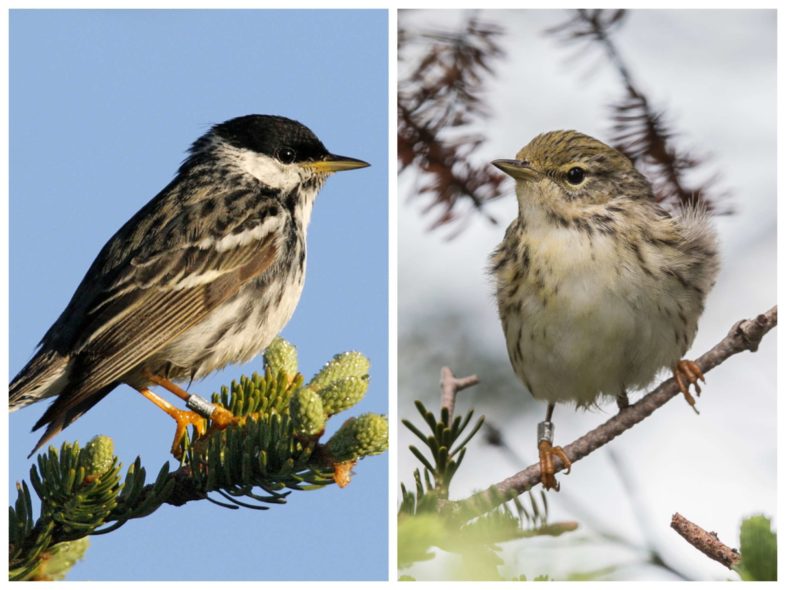
A banded male (left) and female (right) Blackpoll Warbler on Mt. Mansfield. VCE’s mist net captures of 22 individuals (10 males, 12 females) on 1-2 June was an encouraging sign for the mountain’s breeding population of this regionally declining species. Left: © Jeff Nadler; right © Charles Gangas
Somehow, in the seeming blink of an eye, 30 years have elapsed since VCE’s first 1992 foray to Mt. Mansfield, when we began unraveling the life history and ecology of Bicknell’s Thrush (BITH). Three decades later, we’re still at it, though we’ve broadened our efforts to encompass the entire montane forest avian community. We scaled back our intensive efforts a decade ago (i.e., no more nest monitoring, videotaping adults feeding nestlings, radiotracking adults and fledglings, or mapping territories), we are now committed to long-term demographic monitoring through annual constant-effort mist netting and banding on our ~25-acre ridgeline study plot. Ours is the only such study in high-elevation fir-spruce forests of the Northeast. It has yielded a rich body of science, helped inform conservation, been a wonderful proving ground to mentor young biologists, and introduced hundreds of visitors to both VCE and the wonders of birds in the hand.
A VCE crew of 4 launched our 2021 season on a cool, mostly clear afternoon, arriving on the ridgeline at 4:45 pm. Our 22 mist nets were set up and catching birds by 6:30. After a quiet start, we had a flush of captures just prior to dusk and ended the evening with 17 captures, which included 2 BITH banded in previous years, 6 Blackpoll Warblers, 2 Magnolia Warblers, and an out-of-habitat Black-throated Green Warbler. We rolled out our sleeping bags and pads on the gravel parking lot surface and slept under the stars.
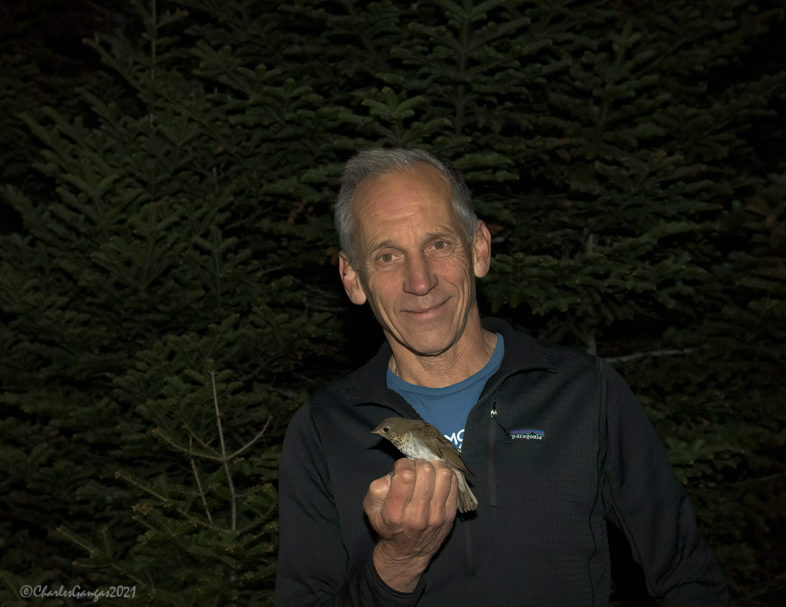
Old Man on the Mountain with VCE’s first mist-netted Bicknell’s Thrush of 2021, an old friend banded in 2018. © Charles Gangas
I was awakened at 4:05 am by the piercing call of a BITH no more than 5 meters away (maybe “payback” from one of the males banded a few hours previously?). We all scrambled up and had nets open by 4:30. Camp stove coffee followed. A cool, partially overcast dawn yielded little activity for ~2 hours, then the floodgates opened, and we had a rush of captures, with steady action through our 11:00 am closing.
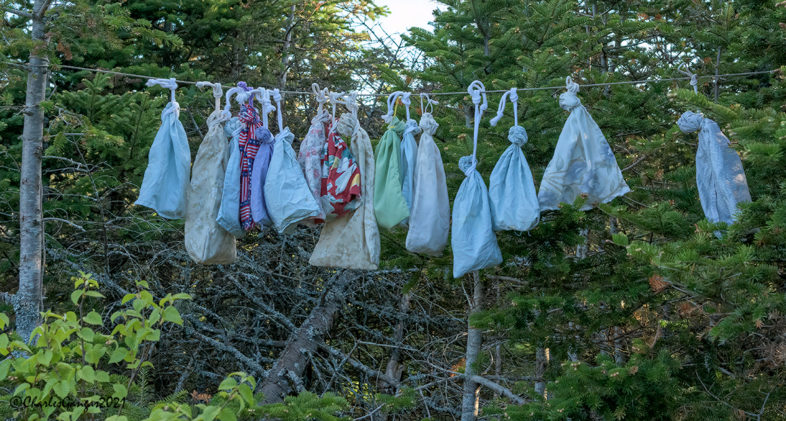
The early morning line-up of bird bags on VCE’s avian clothesline awaits banding and processing. © Charles Gangas
Banding highlights included a trio of Catharus thrushes, with our first-ever Veery, all posing obligingly for handheld photos. Several other non-local adults (vireos, redstart, Blackburnian and 2 more Black-throated Green warblers) may have been birds still prospecting for breeding sites or early-failed nesters (2 had regressing brood patches). Most striking, however, was our haul of Blackpoll Warblers, of which we captured 22 individuals (10 males and 12 females) — more than half our annual total in “lean” Blackpoll years. This was an encouraging, if very preliminary, sign for a species experiencing alarming population declines in the Northeast and elsewhere, according to data from VCEs Mountain Birdwatch and other long-term monitoring programs. We can’t (and won’t) claim that our mist net bounty portends any kind of actual rebound in Blackpoll numbers, but we certainly hope the trend continues.
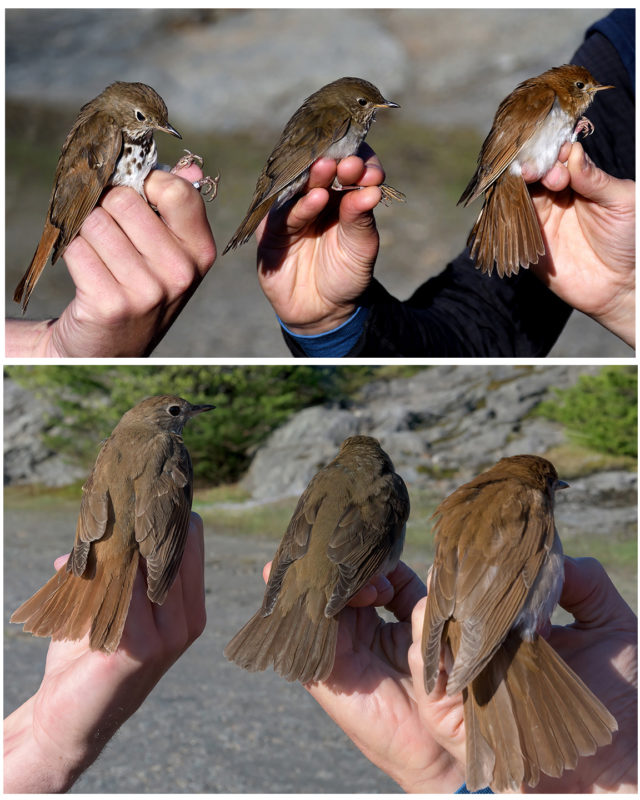
A trio of very similar Catharus thrushes that might test any birder’s (or bander’s) identification mettle. From left: Hermit Thrush, Bicknell’s Thrush, Veery. Top © Mike Sargent; bottom © Charles Gangas
Our total of 58 individuals captured over both days included:
Yellow-bellied Flycatcher — 2 new bandings, sex unknown
Blue-headed Vireo — 1 new male; sang repeatedly after release
Red-eyed Vireo — 1 new, sex unknown
Golden-crowned Kinglet — 1 new female w/regressing brood patch
Veery — 1 new, sex unknown
Bicknell’s Thrush —7 (2 new bandings, 5 return males [1 from 2016 and 2018, 3 from 2020])
Hermit Thrush — 1 new female with regressing brood patch
American Robin — 1 new female with fully-developed incubation patch
Dark-eyed Junco (Slate-colored) — 4 (3 new, 1 return male from 2020)
White-throated Sparrow — 6 (5 new, 1 return male from 2020)
American Redstart — 1 new female
Magnolia Warbler — 2 new (male and female)
Blackburnian Warbler — 1 new female
Blackpoll Warbler — 22 (15 new, 7 returns including 1 male from 2018, 3 from 2020; single females from 2018, 2019, 2020)
Yellow-rumped Warbler (Myrtle) — 4 (3 new bandings, 1 return male from 2019)
Black-throated Green Warbler — 3 new bandings (2 males, 1 female)
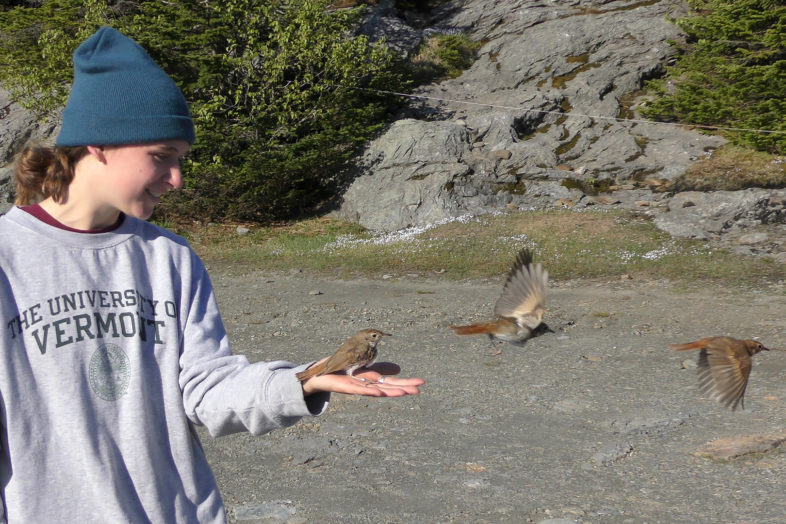
Ani McMannon, VCE’s summer intern from UVM’s Rubenstein School of Environment and Natural Resources, releases a banded Hermit Thrush on Mt. Mansfield, 2 June 2021. © Mike Sargent
During our week 2 visit on 6-7 June, we’ll launch a new research effort, applying miniaturized archival GPS tags to adult BITH, as we seek to understand the species’ late winter and pre-migratory movements on its Caribbean wintering grounds. These tags will collect extremely detailed information on bird’s locations, via 50 or more pre-programmed “fixes” strategically scheduled throughout the time they’re away from Mt. Mansfield. We plan to attach 40 of these tiny backpacks to BITH over the next 2 months, then recover them in 2022. It’s an exciting, innovative approach to learn about a poorly understood period of the BITH annual cycle, one that could have critical implications for conservation. Stay tuned for an update.

And a season of hope for these magical singers begins again, thanks to VCE! That smile on Chris’s face isn’t just for hard science : )… we all need to share the information and the significance of this great work (and amazing photos!). Good luck to the VCE team, and BITHs,
Chris,
A thank you to you and your team for taking the time to share your banding efforts and expertise and for the Bicknell Thrush viewing opportunities. Sue, Mike and I enjoyed it very much and appreciate all the work your team does.